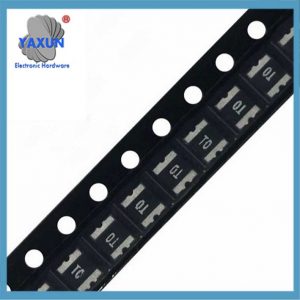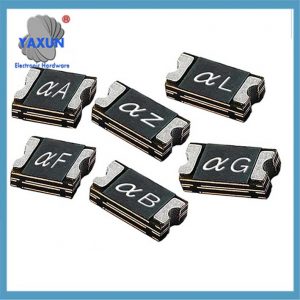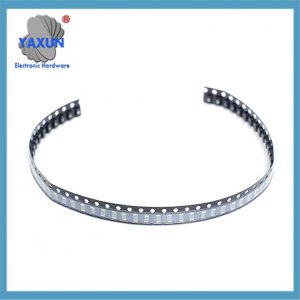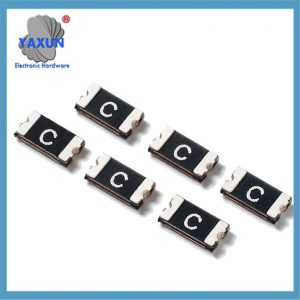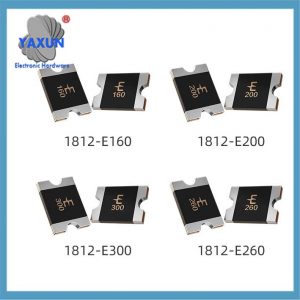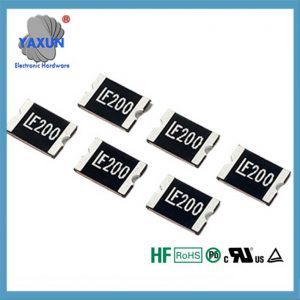A resettable chip fuse, also known as a PTC (Pozitivní teplotní koeficient) resettable fuse, is a type of surface mount device (SMD) that protects electronic circuits from overcurrent and overheating. It acts like a traditional fuse but can automatically reset itself after a fault is cleared. When a fault like an overcurrent or short circuit occurs, the fuse’s resistance increases, limiting the current flow. Once the fault is removed and the fuse cools down, its resistance returns to normal, allowing current to flow again.
The resettable chip fuse (PPTC) is an overcurrent protection element based on the positive temperature coefficient characteristics of a polymer. It has an automatic reset function and is widely used in circuit protection of electronic equipment. Následující jsou jeho hlavní body:
1. Struktura a pracovní princip
Materiální složení
It is composed of a specially treated polymer resin (such as PE polymer) a vodivé částice (Částice uhlíkových nebo kovových částic). Za normálních podmínek, vodivé částice tvoří cestu s nízkou rezistencí (0.1-několik ohmů).
Protection Mechanism
Když dojde k nadměrnému průběhu, Tepelný účinek proudu způsobí, že se pryskyřice roztaví a rozšiřuje, the conductive network breaks, and the resistance suddenly increases to a high resistance state (up to the megohm level), limiting the current to the microampere level.
Po vyřešení závady, vodivé částice chladí a zmenšují, znovu připojit, and return to a low resistance state, without the need for manual replacement.
PTC Behavior:
Resettable fuses utilize a Polymeric Positive Temperature Coefficient (PPTC) materiál. This material exhibits a significant increase in resistance as temperature rises.
Ochrana nadměrného proudu:
When a current exceeds the fuse’s rated value flows, the PPTC material heats up, causing its resistance to increase. This increase in resistance reduces the current flow, preventing damage to the circuit.
Automatický reset:
Once the fault is removed and the fuse cools down, the resistance decreases, allowing normal current flow to resume.
Key Features and Benefits:
Samostavení:
The ability to automatically reset after a fault event makes it a reusable alternative to traditional fuses.
Ochrana nadměrného proudu:
Protects circuits from damage caused by excessive current, short circuits, or overheating.
Space-Saving:
SMD packaging allows for integration into compact electronic devices.
Wide Range of Applications:
Found in various devices, including computers, mobile phones, lékařské vybavení, and automotive electronics.
Příklad:
Imagine a situation where a USB port on a laptop is accidentally short-circuited. A resettable fuse on the USB power line would detect the overcurrent and increase its resistance, limiting the current and preventing damage to the laptop’s power supply and other components. Once the short is removed, the fuse would reset, and the USB port would be ready to use again.
 English
English Afrikaans
Afrikaans العربية
العربية বাংলা
বাংলা bosanski jezik
bosanski jezik Български
Български Català
Català 粤语
粤语 中文(简体)
中文(简体) 中文(漢字)
中文(漢字) Hrvatski
Hrvatski Čeština
Čeština Nederlands
Nederlands Eesti keel
Eesti keel Suomi
Suomi Français
Français Deutsch
Deutsch Ελληνικά
Ελληνικά हिन्दी; हिंदी
हिन्दी; हिंदी Magyar
Magyar Bahasa Indonesia
Bahasa Indonesia Italiano
Italiano 日本語
日本語 한국어
한국어 Latviešu valoda
Latviešu valoda Lietuvių kalba
Lietuvių kalba македонски јазик
македонски јазик Bahasa Melayu
Bahasa Melayu Norsk
Norsk پارسی
پارسی Polski
Polski Português
Português Română
Română Русский
Русский Cрпски језик
Cрпски језик Slovenčina
Slovenčina Slovenščina
Slovenščina Español
Español Svenska
Svenska ภาษาไทย
ภาษาไทย Türkçe
Türkçe Українська
Українська اردو
اردو Tiếng Việt
Tiếng Việt

